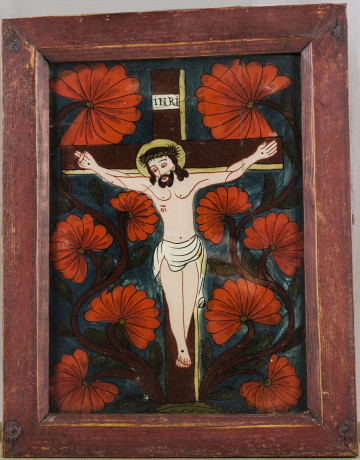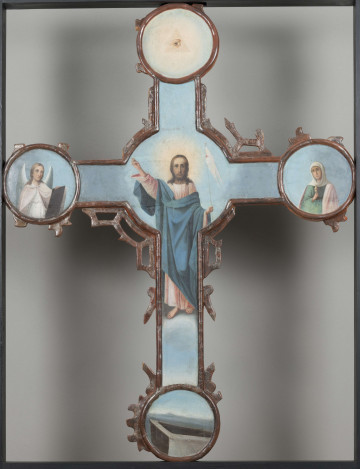
Christ Crucified
1801 — 1900
National Museum in Lublin
Part of the collection: Folk Art of the Lublin Region (17th–1st half of the 20th c.)
Crucifixion as a way of inflicting death, the greatest and most cruel punishment, was used until the 4th century. It was not only a torturous death. It was an expression of the greatest disgrace. That is probably why it did not apply to Roman citizens, who were put to death by beheading with a sword. Crucifixion was used for slaves, degraded soldiers, evildoers and the first Christians.
Before the condemned person was taken to the place of execution, he was scourged, often until he became unconscious. Then a cross bar, 1.5-1.8 m long and weighing 37-54 kg, was strapped to the shoulders. The condemned was escorted by a squad of legionaries, and one of the soldiers carried a plaque with the name and guilt of the condemned, later placed on top of the cross. In the case of Christ, it read: INRI (Iesus Nazarenus Rex Iudaeorum, or Jesus of Nazareth, King of the Jews). Usually the place of execution was on the outskirts of the city or outside it. Going this route was therefore a special kind of torment and humiliation, and at the same time a barbaric spectacle for those gathered.
The Romans usually used two types of cross. The first, called crux commissa, was shaped like the Greek letter Tau (T) and was formed by superimposing a horizontal beam on a vertical one. The second was a Latin folding cross (crux immissa). The third type, used least often, was the oblique cross (crux decussate), commonly called the cross of St Andrew, on which one of the apostles was said to have died. Sometimes an inverted Latin cross was also used - St Peter was to be crucified head down.
After arriving at the place of execution, the cross-beam was pivoted on a pole. In its middle part something like a support was attached to hold up the legs. The condemned person was given a mixture of strong wine and myrrh or gall as a mild intoxicant. He was then crucified with nails 13-18 cm long and 1 cm in diameter. Death occurred in three to four hours, although the agony could last up to three days. It was the custom of the Romans for one of their soldiers to pierce the body with a sword or spear, delivering the fatal blow from the right side of the chest as confirmation of the condemned man's death. Emperor Constantine the Great, who had converted to Christianity, ended the policy of persecuting Christians and outlawed the punishment of crucifixion.
Author / creator
Dimensions
cały obiekt: height: 47,5 cm, width: 69 cm
Object type
picture
Technique
oil technique
Material
canvas, oil-based paint
Creation time / dating
Creation / finding place
Owner
The National Museum in Lublin
Identification number
Location / status

1801 — 1900
National Museum in Lublin

1801 — 1900
National Museum in Lublin

1801 — 1900
National Museum in Lublin
DISCOVER this TOPIC
National Museum in Lublin
DISCOVER this PATH
Educational path